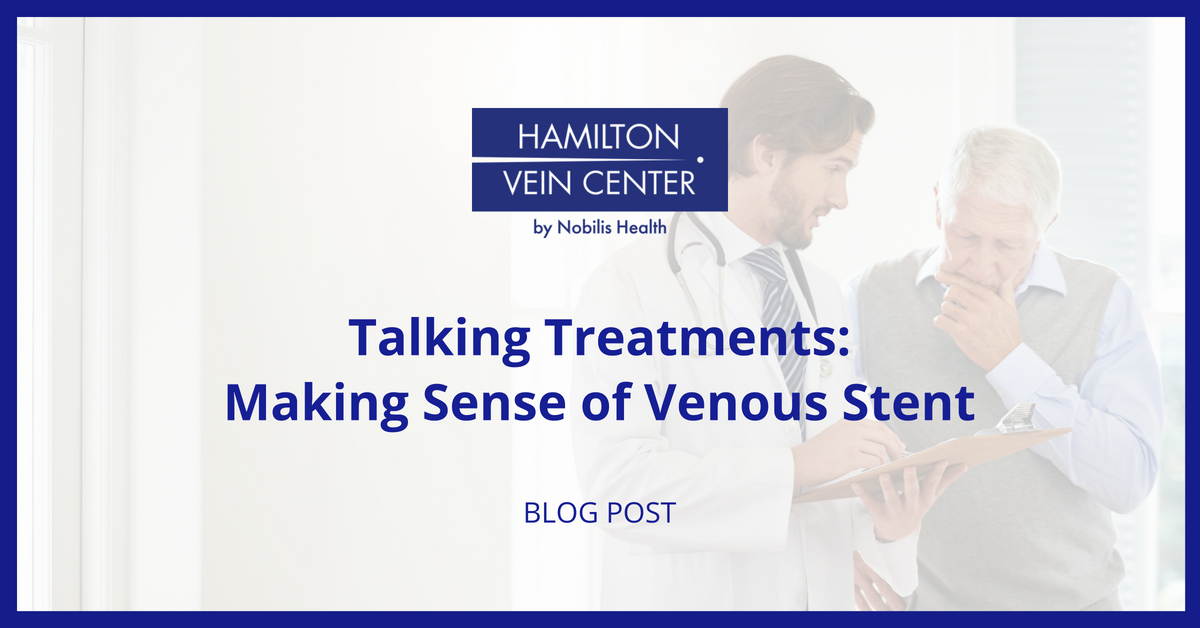Talking Treatments: Making Sense of Venous Stent

The Danger of Pelvic Vein Stenosis
In many ways, pelvic vein stenosis (also known as pelvic congestion syndrome) feels a lot like chronic venous insufficiency (CVI), which makes sense: at the core of it this disorder occurs because of blood circulation problems in the legs. The symptoms—leg and pelvic pain, swelling, ulcers, and varicose vein formation, among others—should not be ignored as this condition can lead to deep vein thrombosis (DVT), potentially fatal blood clots in major arteries. [1]
More often occurring in women but also arising in men, most patients feel pain get worse when they put pressure on the pelvis as in sitting. This pain and other symptoms often become chronic and difficult to manage. Luckily, pelvic vein stenosis can be treated through the placement of venous stents. This approach is highly effective and is often recommended when initial treatments do not resolve the issue.
Let’s take a closer look both at pelvic vein stenosis and venous stent placement.
Anatomy & Diagnosis
Exact causes of this condition are unknown; however, there’s thought to be a hormonal association in women, and anatomic abnormalities can also be genetic in nature. What’s happening down there? Primarily, pelvic vein stenosis can be traced to problems in the great and small saphenous veins (GSV and SSV respectively). The GSV, which is the longest vein in the human body, runs along the surface from the big toe to the femur. The SSV, similarly, goes from the little toe and merges with others before linking to the GSV. When these are unable to get blood back to the heart, you start seeing symptoms as blood gets stuck in problem areas.
What’s concerning is that this disorder is often mistaken for other conditions because patients are assessed while laying flat, which relieves pressure on veins. [1] Proper diagnosis involves not only physical testing for symptoms but imaging procedures as well. Ultrasound can help physicians rule out other common causes of pelvic pain, and CT scans or MRIs are sometimes useful to provide a better sense of what’s going on. That said, the definitive diagnostic method for this condition is pelvic venography, which can accurately find abnormal veins and areas of reversed blood flow.
Treatment Start to Finish
When the doctor has determined definitively that you have pelvic vein stenosis, the first approach may actually involve venous stents. Instead, doctors will employ other methods, such as radiofrequency ablation (RfA), to essentially seal off problem areas and allow blood to re-route to healthier pathways. [1] In cases of pelvic vein stenosis, however, these methods will not always work.
Venous stents are basically implants that physically hold open the problem vein, allowing for healthy circulation. How are they placed into position? Here’s a quick overview:
- Imaging & IV: X-ray imaging is used to guide the surgeon, and following a small incision and using a catheter (a rigid tube), a contrast medium is injected to allow better view of the problem vein. Naturally, the patient will be numbed to any pain.
- Angioplasty & Implantation: Before the stent itself can be placed into position, the catheter is used to place and then inflate a special balloon in the area, a procedure called angioplasty. Following that, the venous stent is put into position, and then carefully opened up. Once active and in the right place, all the other components—the balloon and catheter itself—are removed.
- Recovery: In all, the procedure only takes about an hour, and a couple more are needed for recovery. In the weeks after venous stent implantation, you’ll feel some discomfort in the region; however, pelvic pain and other symptoms should diminish.
Outcomes for this procedure are overwhelmingly positive; one study published in Circulation Journal noted a success rate over 90 percent. [2] This option, then, is certainly worth considering.
Pitted Against Pelvic Pain
Ultimately, it’s absolutely crucial that conditions like pelvic vein stenosis be treated as soon as possible. These are progressive disorder, meaning they tend to get worse over time. Even if there were no extreme danger—though of course this condition can sometimes lead to fatal other ones—it’s simply not worth suffering in silence. If you suspect your have this disorder, call your doctor immediately.
If you have this condition or any other type of vein disorder, the team at Hamilton Vein & Vascular can help. The experts at these Texas-based outpatient clinics employ nothing but the latest in techniques and technologies to ensure positive outcomes for all of their patients. Talk to one of Hamilton’s Patient Care Managers today by calling their Houston location at (281) 565-0033, the Austin office at (512) 551-1403, or San Antonio at (210) 504-4304.
References
- Christoforatos, Olympia. 2011. “Pelvic Pain And Pelvic Congestion Syndrome: Finally The Relief That Women Seek | Stony Brook University School Of Medicine”. Stonybrookmedicine.Edu. https://medicine.stonybrookmedicine.edu/surgery/blog/pelvic-pain-and-pelvic-congestion-syndrome-finally-the-relief-that-women-seek?page=1.
- Matsuda A, et al. 2018. “Early And Long-Term Outcomes Of Venous Stent Implantation For Iliac Venous Stenosis After Catheter-Directed Thrombolysis For Acute Deep Vein Thromb… – Pubmed – NCBI “. Nlm.Nih.Gov. Accessed July 12 2018. https://www.ncbi.nlm.nih.gov/pubmed/24583973.